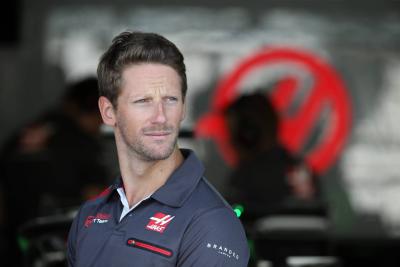Grosjean: ‘Unfair’ F1 tyre rules a ‘big disadvantage’ to Q3 runners
Romain Grosjean says he may change his approach in Russian Grand Prix qualifying due to Formula 1 starting tyre rules resulting in a “big disadvantage” for drivers that progress into Q3.
F1’s regulations state drivers who make it into the final part of qualifying must start the race on the tyres with which they set their fastest time in Q2, while all other drivers have free tyre choice for the race.
Romain Grosjean says he may change his approach in Russian Grand Prix qualifying due to Formula 1 starting tyre rules resulting in a “big disadvantage” for drivers that progress into Q3.
F1’s regulations state drivers who make it into the final part of qualifying must start the race on the tyres with which they set their fastest time in Q2, while all other drivers have free tyre choice for the race.
The rules have resulted in drivers on the cusp of progressing into Q3 changing tactics to try and gain a perceived advantage in the race by qualifying 11th on the grid, with McLaren's Fernando Alonso labelling the position as "perfect" before he went on to finish seventh in Singapore.
When asked if he felt the rule is unfair, Grosjean replied: “Yes it’s definitely not [fair]. If here it’s the same situation we are not going to try to make it into Q3.
“I don’t think that’s great for F1, for the show and for ourselves neither, just thinking ‘oh I don’t want want to make it into Q3’.
“It’s really a big disadvantage, what’s the point of making qualifying then?”
Haas lost ground to midfield rivals Renault in the ongoing battle over fourth place in the constructors’ championship after both drivers failed to score in Singapore.
Grosjean qualified eighth on the grid but said he was forced to “drive like a grandma” in order to preserve his Hypersoft tyres, before ultimately dropping out of the top 10 and finishing 15th.
“I don’t think the pace got away,” Grosjean explained. “It was a rubbish situation to be qualifying between seventh and tenth, and have to start on the Hypersofts, which is a bit sad that knowing that the P13 had an advantage over P7 on the grid.
“So I took it very, very slowly initially in the race, drove like a grandma, trying to take care of the tyres. Five laps after the Safety Car or so, they just went so we had to pit and eventually I ended up in traffic.
“I was with Sergio there and Hulkenberg and we just couldn’t do anything, couldn’t pass the car in front of us. Probably were on the wrong tyres, we were on the Soft and the Ultra was a really good tyre on Sunday.
“I think the pace was there but it was just that we had to start on the hyper and that was a massive disadvantage over the people starting from 11th to 15th, 17th, 18th.”
Haas team principal Gunther Steiner said aiming to qualify just outside of the top 10 is “difficult” to achieve and believes adjustments need to be made to Pirelli’s tyres in future to avoid such big performance gaps between its compounds.
“I think it needs to be more adjusted with the tyres that we don’t have this big gap, in my opinion,” he said. “Because it’s difficult to do this by the regulations, then in some instances, it’s the only time this year where it is such a big advantage.
“You know sometimes when you are 10th, you say would it be better being 11th and on a free choice, but normally it’s better to be in Q3. If you are competitive you should aim to be in Q3 and not strategise to be just outside of Q3.”



![Johann Zarco, LCR, Honda RC213V, 2024 San Marino MotoGP, Misano, action [Gold & Goose]](https://cdn.crash.net/styles/thumbnail/s3/2024-09/GnG_1166323_HiRes.jpg?itok=vpgrU7Q4)

![Jack Miller, KTM Factory Racing, KTM RC16, San Marino MotoGP, Misano, action [Gold & Goose]](https://cdn.crash.net/styles/thumbnail/s3/2024-09/GnG_1167624_HiRes.jpg?itok=iz7mA4EQ)


![Fabio Quartararo, Monster Energy Yamaha Racing, Yamaha M1, 2024 MotoGP, Misano Test, action [Gold & Goose]](https://cdn.crash.net/styles/thumbnail/s3/2024-09/GnG_1168928_HiRes.jpg?itok=fcYSole_)
![Toprak Razgatlioglu, ROKiT BMW Motorrad, BMW M 1000 RR, Magny-Cours, WorldSBK [Gold & Goose]](https://cdn.crash.net/styles/thumbnail/s3/2024-09/GnG_1165133_HiRes.jpg?itok=GD5SVNVG)

